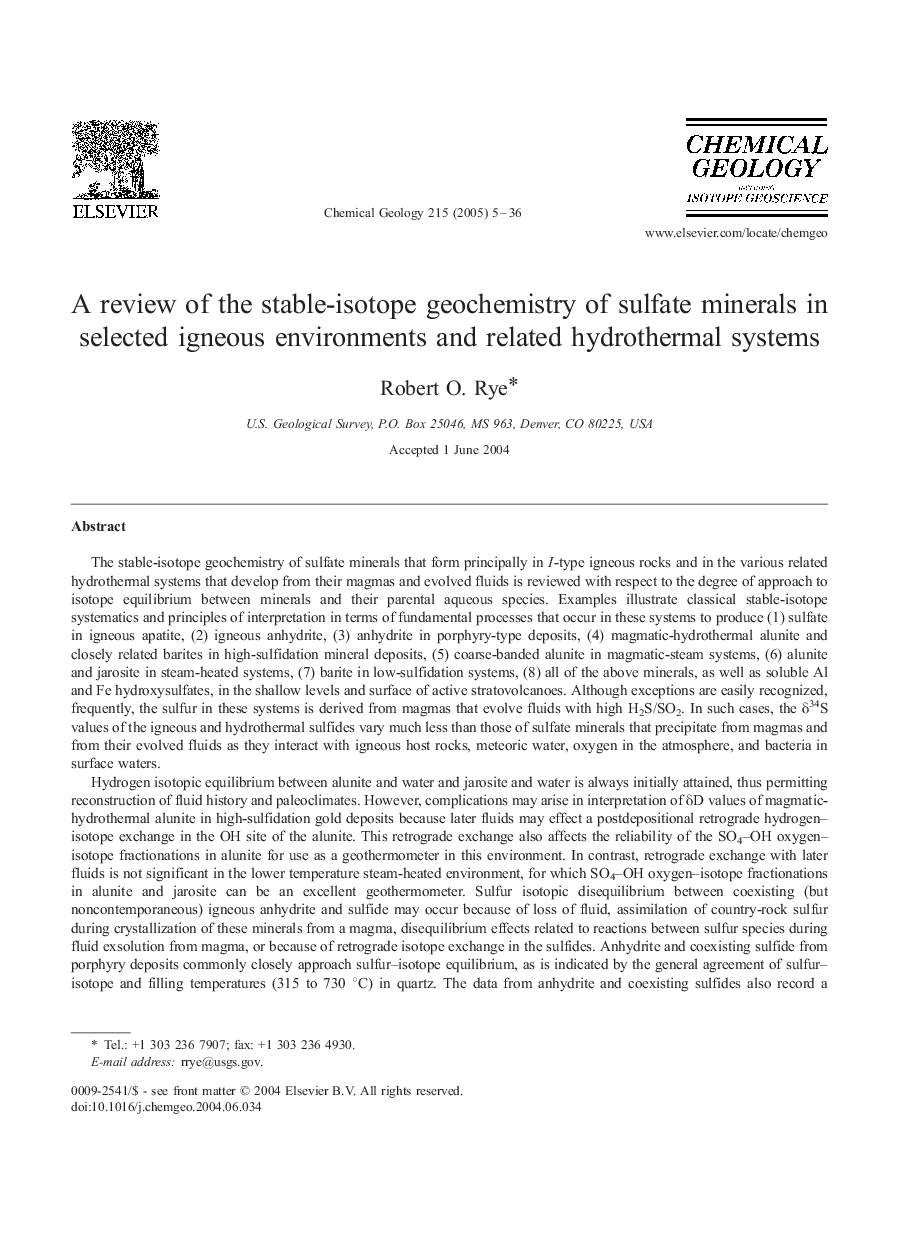| کد مقاله | کد نشریه | سال انتشار | مقاله انگلیسی | نسخه تمام متن |
|---|---|---|---|---|
| 9529207 | 1637793 | 2005 | 32 صفحه PDF | دانلود رایگان |
عنوان انگلیسی مقاله ISI
A review of the stable-isotope geochemistry of sulfate minerals in selected igneous environments and related hydrothermal systems
دانلود مقاله + سفارش ترجمه
دانلود مقاله ISI انگلیسی
رایگان برای ایرانیان
کلمات کلیدی
موضوعات مرتبط
مهندسی و علوم پایه
علوم زمین و سیارات
ژئوشیمی و پترولوژی
پیش نمایش صفحه اول مقاله

چکیده انگلیسی
Hydrogen isotopic equilibrium between alunite and water and jarosite and water is always initially attained, thus permitting reconstruction of fluid history and paleoclimates. However, complications may arise in interpretation of δD values of magmatic-hydrothermal alunite in high-sulfidation gold deposits because later fluids may effect a postdepositional retrograde hydrogen-isotope exchange in the OH site of the alunite. This retrograde exchange also affects the reliability of the SO4-OH oxygen-isotope fractionations in alunite for use as a geothermometer in this environment. In contrast, retrograde exchange with later fluids is not significant in the lower temperature steam-heated environment, for which SO4-OH oxygen-isotope fractionations in alunite and jarosite can be an excellent geothermometer. Sulfur isotopic disequilibrium between coexisting (but noncontemporaneous) igneous anhydrite and sulfide may occur because of loss of fluid, assimilation of country-rock sulfur during crystallization of these minerals from a magma, disequilibrium effects related to reactions between sulfur species during fluid exsolution from magma, or because of retrograde isotope exchange in the sulfides. Anhydrite and coexisting sulfide from porphyry deposits commonly closely approach sulfur-isotope equilibrium, as is indicated by the general agreement of sulfur-isotope and filling temperatures (315 to 730 °C) in quartz. The data from anhydrite and coexisting sulfides also record a significant range in H2S/SO42â and δ34SΣS among deposits and even during the course of mineralization at a single deposit. Sulfur isotopic disequilibrium among aqueous sulfur species may occur in any hydrothermal environment except the relatively high-temperature (200-400 °C) low-pH (<3) magmatic-hydrothermal environment, in which SO42â forms along with H2S from the disproportionation of SO2 during the condensation of a magmatic vapor plume. Magmatic-steam alunite forms from expanding SO2-rich magmatic vapors that rise so rapidly that sulfur isotopic exchange between SO42â and H2S does not occur during disproportionation of SO2. Such alunite has δ34S values similar to that of the bulk sulfur in the magma. Residence times of SO42â in steam-heated systems, although seldom long enough to permit more than partial sulfur-isotope exchange with streaming H2S, often are long enough to permit oxygen-isotope equilibrium with water. In active stratovolcanoes, aqueous sulfate derived from the disproportionation of SO2 and the oxidation of H2S can also mix with that derived from the oxidation of pyrite near the surface. In the near-neutral low-sulfidation system at Creede, CO, isotopic exchange among hydrothermal aqueous species was so slow that sulfur and even oxygen isotopic signatures derived from bacteriogenic and thermochemical reduction of sulfate in moat sediments are observed in hydrothermal barite.
ناشر
Database: Elsevier - ScienceDirect (ساینس دایرکت)
Journal: Chemical Geology - Volume 215, Issues 1â4, 15 February 2005, Pages 5-36
Journal: Chemical Geology - Volume 215, Issues 1â4, 15 February 2005, Pages 5-36
نویسندگان
Robert O. Rye,